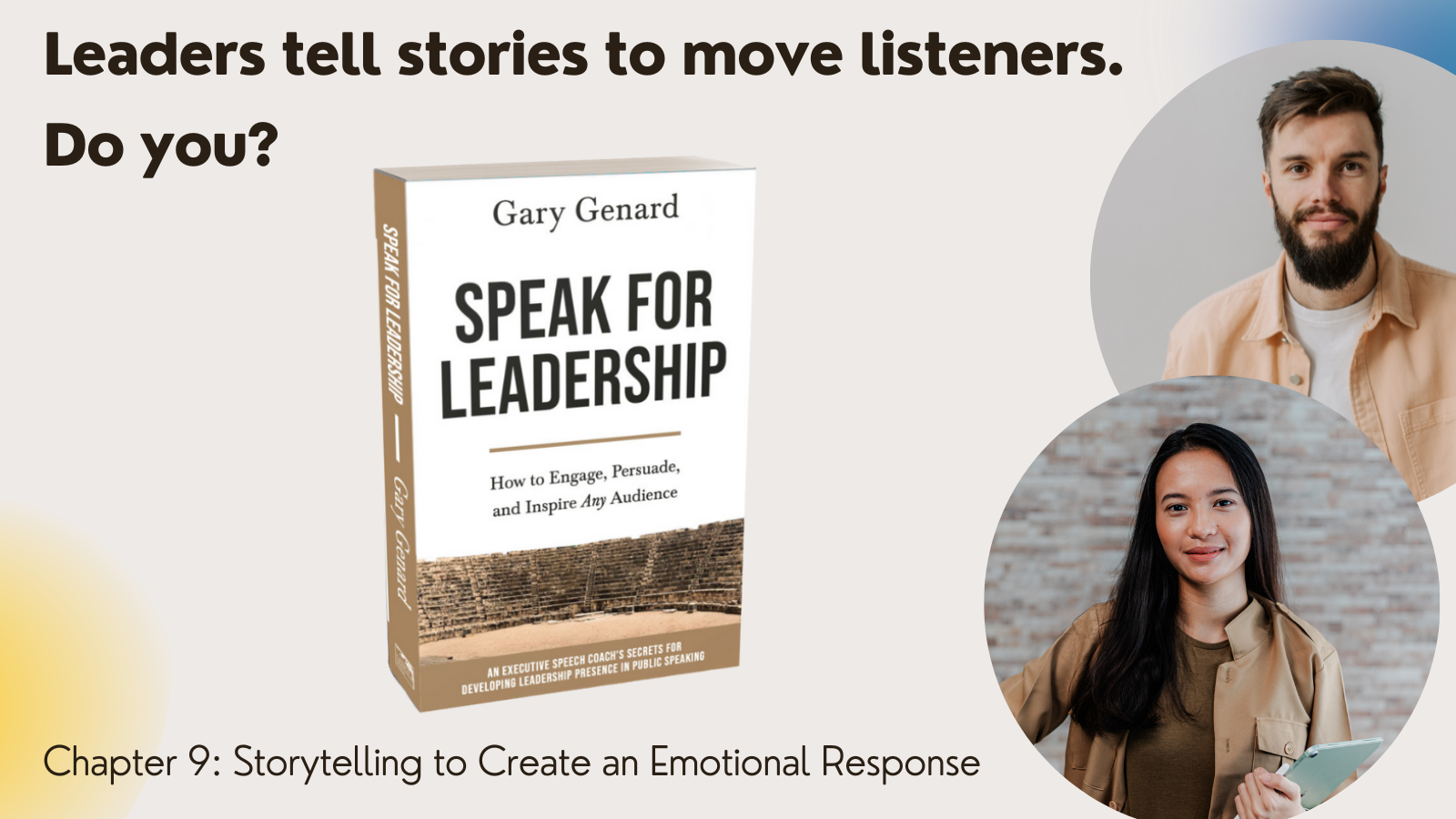It's a lecture that packs an emotional wallop. The talk ties the tragedy to an opportunity to see one of its victims dancing again for the first time on the TED stage.
Do you tell stories that carry an emotional wallop? If you want listeners to retain what you say, you should! Learn how in my book, Speak for Leadership. Find it here on Amazon.
How to Make Your Speeches Emotionally Powerful
Through performances like Hugh Herr's TED talk, we see how emotion can transcend content and even an unemotional speaker. That's key to great keynote speaking or other events where you're looking for a maximum payoff in terms of how to engage and succeed with audiences.
You can and should develop your message in ways that tap into emotional reservoirs. Often, it's really about your audience's emotional experience—a response that can occur in analytical, financial, or technical presentations as well as more emotionally-based content. In fact, if you frequently discuss topics in these areas, it's critically important that you understand how emotions work on audiences.
Want to get good—really good—at engaging and moving listeners? Get my Free Guide, Six Rules of Effective Public Speaking. Download it now!
Below are five ways you can consciously create an emotional encounterr between you and listeners. Do that, and your influence will soar. Most speakers just deliver content, which almost never reaches an emotional plane. Instead, here are my five rules for achieving emotional power in your speeches and presentations.
1. Develop an Emotional Message.
At The Genard Method of performance-based public speaking training in Boston, we teach clients to speak emotionally in everything they say. After all, your job is always to meet your audience's needs (including emotionally)! It why you shouldn't focus exclusively on content. The content bandwagon is always bright and shiny and fun to hop on. But influence is the be-all and end-all in public speaking situations.
You should therefore ask yourself at every stage of preparation if what you're putting together will serve your purpose. One great way to do so is to learn how to perform an audience analysis. Since to influence means to change thoughts, feelings, or actions—all emotional experiences—you must find the emotional wavelength. What will reach these listeners where they live, and so change their lives for the better? This is so far above the bare delivery of information that it shouldn't even need stating, but it does.
Get better at connecting with listeners with my Free Tips and Tricks Guide, 20 Ways to Connect With An Audience For Lasting Influence. Get on your audience's wavelength!
2. Show Your Engagement.
Content can never live on its own. It's your place to make it come to life, sparking electricity between you and the audience. The good news is that you can just be you to make that happen. In fact, the connection won't occur otherwise. All your audience ever wants is you, speaking honestly about something you believe in.
So here's a simple formula to live by: zero in on your relationship with your audience and forget about how you're doing. Worrying about your performance will push you toward artificially creating an "excellent" end result. Instead, just engage listeners. They'll respond!
Great speaking depends as much on your performance as your material! Find out why in my free Insights article, "Great Speaking? It's About Performance Over Content!"
3. Use Emotional Language.
Making emotional connections with other human beings isn't difficult if you share an interest in the same topic. But to do so, you need to use the language of emotion.
How could you succeed without doing that if you're trying to move listeners? Emotional words and connotations create a heartfelt response in people. "Love" beats "like." "Should" pales next to "must." Listen to the difference between: "I like this development" and "I love this solution!"
Look for words that sing rather than mumble; that run headlong instead of stroll. As Mark Twain said, "The difference between the right word and the almost right word is the difference between lightning and the lightning bug."
4. Create An Emotional Experience.
It's all part of creating an emotional experience for your audience. Never be satisfied with just conveying information, as nothing is more boring for listeners. Why educate when you can inspire? Why motivate when you can fire up? Why influence when you can change lives?
One key to creating an emotional experience is simply wanting to do so. If you're shy about transforming the lives of the people in the room, don't speak in public. If you think that you can't reach audiences on an emotional level, maybe public speaking isn't for you. Memos, PowerPoint decks, and meeting minutes don't need you to explain much. They deliver their information efficiently. You're the human being who needs to be on hand to tell us what it all means.
Here's a valuable tip: improve your voice so you fire up, not cool down listeners! Download my Free resource, "Do You Speak Like This? (It Can Hurt Your Credibility)".
5. Open the Emotional Gate.
Here's the last of my five ways to achieve emotional power in your talks. To be open to your exciting (and emotionally engaging) ideas, audiences need you to show the way. If you're not exhibiting an emotional response yourself, why should they? If you're only conveying information without much humanity, they may give up on you.
Sure, you're not perfect and never will be. You'll also never deliver a perfect presentation. But every time you present, you give audiences a unique gift: a person speaking in real time, in a hire-wire act where there's no net. Your willingness to do so is a powerful way to get people to listen to and like you. It will help create both leadership and charisma. It will open you to them, and them to you. After all, the emotional gate swings both ways.
This blog was originally published in 2014. It is updated here.
You should follow me on Twitter here.
Ready to speak with the power that impacts and influences stakeholders? The Genard Method trains leaders, spokespersons, government representatives, and business professionals worldwide in speaking for leadership.
Gary Genard is an actor, author, and expert in public speaking and overcoming speaking fear. His company, The Genard Method offers live 1:1 Zoom executive coaching and corporate group training worldwide. In 2022 for the ninth consecutive year, Gary has been ranked by Global Gurus as One of the World’s Top 30 Communication Professionals. He is the author of the Amazon Best-Seller How to Give a Speech. His second book, Fearless Speaking, was named in 2019 as "One of the 100 Best Confidence Books of All Time." His handbook for presenting in videoconferences, Speaking Virtually offers strategies and tools for developing virtual presence in online meetings. His latest book is Speak for Leadership: An Executive Speech Coach's Secrets for Developing Leadership Presence. Contact Gary here.
Main photo credit: Amadeo Valar on unsplash.com.





